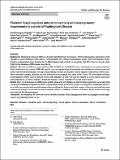Por favor, use este identificador para citar o enlazar a este item:
http://hdl.handle.net/10261/348770COMPARTIR / EXPORTAR:
 SHARE SHARE
 CORE
BASE CORE
BASE
|
|
| Visualizar otros formatos: MARC | Dublin Core | RDF | ORE | MODS | METS | DIDL | DATACITE | |

| Título: | Thalamic Foxp2 regulates output connectivity and sensory-motor impairments in a model of Huntington's Disease |
Autor: | Rodríguez-Urgellés, Ened; Casas-Torremocha, Diana; Sancho-Balsells, Anna; Ballasch, Iván; García-García, Esther CSIC; Miquel-Rio, Lluis; Manasanch, Arnau; Del Castillo, Ignacio; Chen, Wanqi; Pupak, Anika; Brito, Veronica; Tornero, Daniel; Rodríguez, Manuel J.; Bortolozzi, Analía CSIC ORCID; Sanchez-Vives, Maria V.; Giralt, Albert; Alberch, Jordi CSIC | Palabras clave: | Basal ganglia Dendritic spines Electrophysiology Motor coordination R6/1 Sensory information Thalamus |
Fecha de publicación: | 21-nov-2023 | Editor: | Springer Nature | Citación: | Cellular and Molecular Life Sciences 80: 367 (2023) | Resumen: | Huntington's Disease (HD) is a disorder that affects body movements. Altered glutamatergic innervation of the striatum is a major hallmark of the disease. Approximately 30% of those glutamatergic inputs come from thalamic nuclei. Foxp2 is a transcription factor involved in cell differentiation and reported low in patients with HD. However, the role of the Foxp2 in the thalamus in HD remains unexplored. | Versión del editor: | https://doi.org/10.1007/s00018-023-05015-z | URI: | http://hdl.handle.net/10261/348770 | DOI: | 10.1007/s00018-023-05015-z | ISSN: | 1420-682X | E-ISSN: | 1420-9071 |
| Aparece en las colecciones: | (IIBB) Artículos |
Ficheros en este ítem:
| Fichero | Descripción | Tamaño | Formato | |
|---|---|---|---|---|
| s00018-023-05015-z.pdf | 16,4 MB | Adobe PDF |  Visualizar/Abrir |
CORE Recommender
Page view(s)
27
checked on 27-abr-2024
Download(s)
8
checked on 27-abr-2024
Google ScholarTM
Check
Altmetric
Altmetric
Este item está licenciado bajo una Licencia Creative Commons

